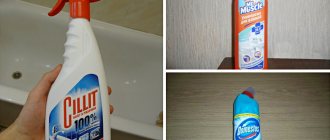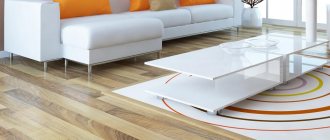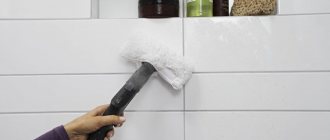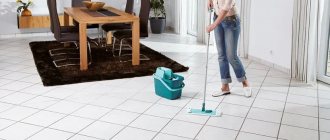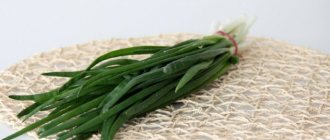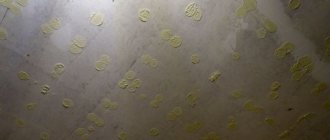When choosing floor tiles, in most cases, first of all, attention is paid to aesthetic perception, size, manufacturer, and cost. And few people think that there is another very important indicator - the texture of the material. As a rule, it is smooth and rough. It is with the latter that some problems may arise. It is more difficult to clean such floor tiles than glossy ones, since they have very small grooves on the surface into which dirt is constantly clogged.
How can you clean porcelain tiles?
To care for porcelain tiles, it is quite possible to use ordinary household chemicals with a mild composition. Do not use abrasive powders or creams; you will scratch the tiles. This will be especially noticeable if you have to remove glazed porcelain tiles.
Interesting materials:
Is it possible to install sockets in the bathroom? Is it possible to lay linoleum in a dacha? Is it possible to cut a synthetic wig? Is it possible to trim juniper? Is it possible to get a haircut on November 4th? Is it possible to get Ilya’s haircut? Is it possible to dry a pillow on a radiator? Is it possible to dry morels? Is it possible to have beets on Dukan? Is it possible to sell homemade wine in Ukraine?
How to clean rough floor tiles
Rough tiles on the floor need to be washed a little more often, since various small cavities fill much faster with dust, sand, and small debris. And usually, the usual mops and sponges are not suitable for this process. There are also certain rules that contain clear recommendations for caring for this type of material.
Basic Rules
What not to do:
- use metal brushes and scrapers, since the surface in most cases has a special coating that can be easily damaged if not properly maintained;
- use aggressive agents based on alcohol, acetone, solvents, chlorine;
- powder products, undiluted, are likely to cause you even more trouble, so when choosing, it is better to give preference to liquid products that do not contain solid particles;
- wash with a cloth made of wool or other materials with long fibers, as they will cling to the grooves and clog them even more.
Sometimes rough tiles can feel like sandpaper to the touch. This is a special coating, which is distinguished by the fact that the material is absolutely non-slip. It is most often used in the bathroom, where there is high humidity and, as a result, the risk of falls and injuries. Sometimes even more problems arise with such a surface, since usually everything you can think of sticks to it.
How to wash rough tiles with grooves or sand coating so that the process is easy and does not take too much time?
- Use non-fibrous materials. For example, a microfiber cloth or a mop with rubber attachments. They will not cling to the surface and leave behind even more debris. Brushes with medium-hard bristles are also very good at cleaning grooves from dirt. In addition, they can be used to easily clean even the deepest cavities and recesses.
- Before you start mopping the floor, be sure to use a broom or vacuum cleaner for dry cleaning. This way you can collect as much small debris as possible.
- If the tiles are heavily soiled and the cavities are clogged with dirt, it is permissible to apply some product to the surface. It will dissolve all dirt and make the cleaning process much easier.
What are we going to wash?
Fat and food microparticles
Minor stains can be removed with dishwashing detergent or soda solution: add four tablespoons to a liter of water, apply it to the tiles and leave for a few minutes. Clean, rinse with water. We remove more complex stains with a stove cleaner.
Before you start washing the tiles, try steaming them: run hot water into the bathtub, shower or kitchen sink, or run a hot hairdryer over the surface. The pores of the tile will open, and it will be easier to wash off the dirt.
Expert advice on caring for porcelain tiles
To maintain the porcelain stoneware coating in perfect condition, it is recommended to carry out the following activities:
- Wipe the floor with products containing natural or artificial wax. It is applied to the surface and rubbed thoroughly. After this treatment, the floor can be washed with plain water.
- Once a year, apply a protective layer for porcelain tiles to the floor surface.
- To make the surface shiny, add lemon juice or lemon essential oil to the washing water.
- The shine of porcelain tiles is also achieved using a water solution with vinegar.
- To polish glossy surfaces, rub the tiles with a piece of felt cloth.
- If the porcelain stoneware is rough, it is better to use a steam generator or steam vacuum cleaner to clean it, after which it is rubbed with a dry cloth. rough porcelain tiles immediately as they become dirty, then there will be no problems with cleaning them.
Advice! When using aggressive cleaning agents, they must first be tested to ensure safety and cleaning effectiveness. The test should be performed on the tile in an inconspicuous place.
When summing up, it becomes clear that it is better to wipe off any contamination immediately after it appears. But if for some reason this was not done on time, chemicals that can remove any type of stain will come to the rescue.
Sources:
https://dom-team.ru/kak-myt-keramogranit-na-polu/ https://laminatepol.ru/22806-chem-otmyit-keramogranit.html
Errors when purchasing
- Don’t overpay for expensive structured (satin, smeared) porcelain tiles for the floor to clad the technical room.
- The same relief material is beautiful, but not effective for street cladding. Dirt clogging between textured areas makes it difficult to care for ceramics.
- Cheap porcelain tiles can be poorly sized.
- Buying slabs from different batches is fraught with tonal differences.
Laying porcelain stoneware on the floor is preceded by a meaningful choice of material. The choice is determined by the purposes of the cladding and the characteristics of the tile. As a result, the advice boils down to one recommendation: try to match the tasks and properties to each other. Correlate what you learned with the expected result and what is written on the packaging of ceramic granite.
- Choosing polished porcelain tiles: what is good about a glossy surface?
- What is good about lappatted porcelain tiles?
- Laying porcelain tiles on the floor: work technology from A to Z
Characteristics of porcelain stoneware that you need to pay attention to
Strength
We mentioned this option above. On the MOHS scale, matte porcelain tile is second only to diamond, leaving marble and granite behind. Despite the varying degrees of strength, any type of artificial stone surpasses most finishing materials in this parameter.
Mohs scale. For example, ordinary sand has a hardness of 7. Therefore, when laying, you must immediately remove the remaining mixture from the surface and seams so as not to damage the coating before use. Lay a rug on the floor in the hallway that will collect all the sand from the street.
Moisture resistance
Low porosity ensures almost complete absence of water absorption - up to 0.05%. Thus, rooms and facades can be decorated based on this aspect using any type of porcelain stoneware. Thanks to the hydrobarrier, the material tolerates temperatures down to -50. Conventional ceramics, due to their absorbent structure, are quickly destroyed at subzero temperatures.
Wear resistance
Abrasion resistance is measured on the PEI scale, which is graded into five classes:
- I – wall ceramic granite;
- II – porcelain stoneware for the floor of residential premises with low traffic;
- III – slabs for medium-traffic areas (up to hundreds of people per hour);
- IV – ceramic granite for public places with traffic up to several hundred people per hour;
- V – porcelain tiles for the floors of areas with the most intense traffic (stations, airports);
The packaging, which always indicates the class of the tile, will help determine the appropriate material.
Designation of pictograms on packaging with tiles.
Format
Porcelain tiles imitating natural stone 30x30 cm Keope Ceramiche Alpi (Italy).
Thickness
Porcelain tiles for flooring are produced in thicknesses of 7-30 mm. The thicker, the more durable. The parameter is directly related to the degree of abrasion.
Load resistance
The maximum load that ceramic granite can withstand, according to one classification, is 2000 N. The bending strength is 45–55 MPa. For comparison: the UNI EN 14441 standard is 27 MPa. Specific indicators depend on the thickness, size of the tile and load. The video shows the strength testing of porcelain stoneware. A 30-ton truck drives over large-format slabs.
Other types of pollution
You can deal with any type of dirt on tiles using the above methods. The choice of cleaning method depends on the complexity of the situation. You can wash the seams, remove brilliant green, and polyurethane foam using regular ammonia.
Recently, ceramic tiles have become especially popular because they are durable, easy to maintain and aesthetically attractive. There are a large number of different cleaning products for this floor covering, but you should approach their choice very carefully. The use of household chemicals can lead to serious health problems and skin irritations. A significant disadvantage of household chemicals is their high cost.
Detergents and practical tips
How to clean the surface of wood-effect tiles
Wood-effect tiles imitate the surface of wood, repeating grooves and other “defects” of wood. To clean such a surface, you need to regularly use a floor mop, and for degreasing, solutions containing 1% buffered acid are used, such as vinegar, boron solution, and ethyl alcohol-based solutions. Degreasing is done by applying the solution with a rough cloth and vigorously rubbing the coating. After the solution has been applied, the surface is washed again and allowed to dry. The floor is then wiped using a microfiber mop.
Such solutions can also be used for daily cleaning, but more water must be used.
The most important thing in cleaning floor tiles is regular cleaning.
How to clean porcelain tiles on the floor after renovation
Contamination of tile floors after construction work is very disappointing. Its surface is capable of reacting to the composition of the cleaning agent, depending on the raw materials used in production.
Clinker tiles are formed using the extrusion method or wet pressing, after which they are fired for a long time at high temperatures. Porcelain stoneware is made by semi-dry pressing, and then, just like clinker stone, it is subjected to long-term firing. These types of products are universal in use. They are used for cladding facades, laid on floors and walls in apartments and houses, and widely used in landscape design.
After repairs, you can thoroughly clean the floor tiles from dirt using an industrial solution purchased in a store, or you can prepare a cleaning composition yourself.
Several products are suitable for cleaning porcelain tiles. Including liquid for cleaning bathrooms, hydrochloric acid, glass cleaner.
Tools at hand that can be used to clean up a tiled floor:
- Liquid for cleaning bathrooms . Apply this mixture onto the stains several times.
- Table salt - pour it over the dirt stains and moisten with water.
- 5% hydrochloric acid - treat the tiles with it.
- Windshield cleaning fluid - treat dirt, then wipe.
- Tooth powder – sprinkle on stains, add a small amount of water, clean with a stiff brush.
If you can’t wash it with improvised means, buy a special solution to combat a specific type of contamination. Please read the instructions for use carefully.
In case of significant damage to the tiled floor, invite qualified specialists who will quickly and efficiently carry out the entire scope of the necessary work.
Methods for cleaning old contaminants
There are two methods for removing old stains - mechanical and chemical.
- 1) Mechanical - fighting stubborn dirt with a knife or a metal brush. You should not carry out the processing too intensively, because there is a high probability of damaging it. This cleaning method is well suited for removing old putty and cement after repairs.
- 2) Chemical – treatment of contaminants using chemical solutions.

